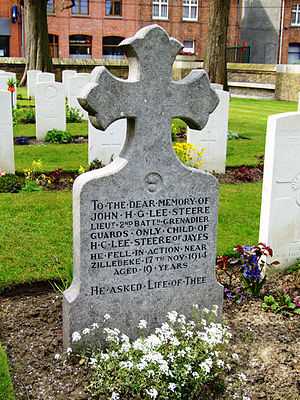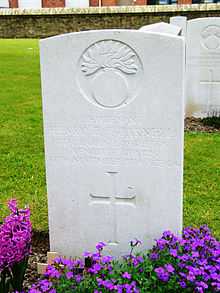Zillebeke Churchyard Commonwealth War Graves Commission Cemetery
| Zillebeke Churchyard | |
|---|---|
| Commonwealth War Graves Commission | |
 | |
| Used for those deceased 1914 | |
| Established | 1914 |
| Location |
50°50′09″N 02°55′21″E / 50.83583°N 2.92250°E near Ieper, West Flanders, Belgium |
| Designed by | W H Cowlishaw |
| Total burials | 32 |
| Burials by nation | |
| |
| Burials by war | |
|
World War I: 32 | |
| Statistics source: WO1.be | |
Zillebeke Churchyard Cemetery is a Commonwealth War Graves Commission burial ground for the dead of the First World War located near Ypres (now Ieper) in Belgium on the Western Front.
The cemetery grounds were assigned to the United Kingdom in perpetuity by King Albert I of Belgium in recognition of the sacrifices made by the British Empire in the defence and liberation of Belgium during the war.[1]
Foundation

In the early days of the war, whilst the front line was still mobile, specific cemeteries for soldiers were comparatively rare and the dead were often buried in local churchyards or municipal burial grounds near where they were killed. Zillebeke was on the front line for much of the war and its churchyard was used for the war dead.[2] These 1914 burials of British and Canadian soldiers[3] reflect the mobility of the front line as they are largely of officers,[2] and reflect the officer class[4] of that point in the war as they were nobility[5] or the sons of the wealthy and the well-connected.[6] As such, the cemetery deviates from almost every other Commission burial ground by having two private memorials,[7] breaking the "equality in death"[8] principle the Commission was founded under and not complying with Sir Frederic Kenyon's report, still otherwise followed to this day, that Commission cemeteries "were designed to avoid class distinctions that would conflict with the feeling of 'brotherhood' which had developed between all ranks serving at the Front".[9] The private memorials are a headstone dedicated to Lieutenant John Henry Gordon Lee-Steere[10] and the tomb of Second Lieutenant Baron Alexis George de Gunzburg.[11]
Amongst the nobility or well-connected buried in the cemetery are Lieutenant Henry Parnell, 5th Baron Congleton,[12] Major Lord Bernard Charles Gordon-Lennox, son of Charles Gordon-Lennox, 7th Duke of Richmond[13] and the Hon William Reginald Wyndham, son of Henry Wyndham, 2nd Baron Leconfield.[14]
The Commission part of the cemetery was designed by W H Cowlishaw.[2]
References
- ↑ First World War, accessed 19 August 2006
- ↑ 2.0 2.1 2.2 "Zillebeke Churchyard". Cemetery Details. CWGC. Retrieved 2008-05-05.
- ↑ "Zillebeke Churchyard". The Great War in Flanders Fields. wo1.be. Archived from the original on 2007-08-13.
- ↑ Bourne, John. "University of Birmingham: Centre for First World War Studies: 'Lions Led By Donkeys'". firstworldwar.bham.ac.uk. Retrieved 2008-05-05.
- ↑ "World War One Battlefields : Zillebeke and area". ww1battlefields.co.uk. Retrieved 2008-05-05.
- ↑ "Zillebeke". The Long, Long Trail. 1914-1918.net. Archived from the original on 2008-07-17.
- ↑ "Zillebeke & The Caterpillar Crater". bujold.co.uk. Archived from the original on 2008-05-17.
- ↑ Braybon, Gail (2003). Evidence, History, and the Great War: Historians and the Impact of 1914-18. Oxford: Berghahn Books. p. 39. ISBN 1-57181-724-7.
- ↑ Modern wording, not from the report, from A History of the Commonwealth War Graves Commission, accessed 2008-05-05
- ↑ "Lee-Steere, John Henry Gordon". Wereldoorlog I in de Westhoek [The Great War in Flanders Fields] (in Dutch). wo1.be. Archived from the original on 2012-02-07.
- ↑ "De Gunzburg, Alexis George". Wereldoorlog I in de Westhoek [The Great War in Flanders Fields] (in Dutch). wo1.be. Archived from the original on 2012-02-07.
- ↑ "Congleton, 5th Baron". Casualty Details. CWGC. Retrieved 2008-05-05.
- ↑ "Gordon-Lennox, Lord Bernard Charles". Casualty Details. CWGC. Retrieved 2008-05-05.
- ↑ "Wyndham, The Hon. William Reginald". Casualty Details. CWGC. Retrieved 2008-05-05.
External links
-
 Media related to Zillebeke Churchyard at Wikimedia Commons
Media related to Zillebeke Churchyard at Wikimedia Commons -
- Cemetery register: Details
- Reports
- Plans
- Photographs. CWGC.
- Zillebeke Churchyard at Find a Grave